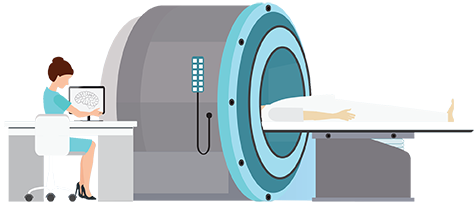

Bone density scanners measure the amount of mineral matter per square centimeter in a patient’s bones, in order to assess the risk of fracture or osteoporosis. Women are especially susceptible to bone density loss as they age, but the problem affects men as well. Ten million Americans currently suffer from osteoporosis, of whom 8 million are women and 2 million men. Another 34 million Americans have low bone mass, which puts them at an increased risk for the disease.
There are multiple tests used to test bone density, but the most widely used is dual-energy X-ray absorptiometry (DXA). DXA uses two X-ray beams of different energies to measure the bones’ mineral content through rate of absorption. The technology was pioneered by medical physicist John R. Cameron of the University of Wisconsin-Madison in the 1960s. Cameron invented single photon absorptiometry (SPA), which was adapted by Norland Corporation and then Lunar Radiation Corporation, now GE Lunar. The technology evolved into dual photon absorptiometry in the 1980s, which then became DXA in 1987, released by Hologic, Inc.
Bone density scans typically pose low risks for most patients. They rely on a very small amount of radiation, less than one-tenth the amount involved in a standard chest X-ray and less than a typical day’s worth of exposure to natural radiation. Bone density scanning is a simple and quick procedure, usually lasting between 10 and 30 minutes. No radiation remains in the patient’s body after the scan and there are no complications associated with the procedure. However, pregnant women should avoid the procedure if possible or discuss their options with their physician or technologist to minimize radiation risks to the fetus.
Bone density scans are important for those at risk for osteoporosis or fractures, particularly post-menopausal women. Other risk factors include a history of smoking, eating disorders, a diet low in calcium or vitamin D or certain medical conditions such as diabetes, hyperparathyroidism or bowel disease. Bone density scans can help indicate the risk of fracture so that steps can be taken to prevent further bone loss. Regular scans for those found to be at risk for osteoporosis also help doctors monitor the effects of treatment.
In order to become a technologist who can perform bone density scans, you will usually need to have an educational background in general radiologic technology. You may become a Certified Bone Densitometry Technologist (CBDT) through the International Society for Clinical Densitometry (ISCD, iscd.org), but this is usually a step taken after the completion of an associate degree in radiologic technology.
While bone density scans are a relatively safe procedure, there is always a small risk associated with X-ray radiation. For those who wish to avoid any exposure to radiation, bone density can also be measured via ultrasound, which relies on sound waves rather than X-rays. It is usually performed on the heel and can predict risk of fracture, though it can be less accurate in determining bone loss in the hip and spine.